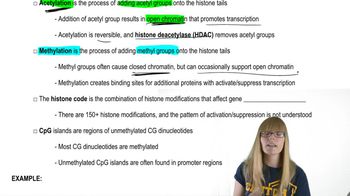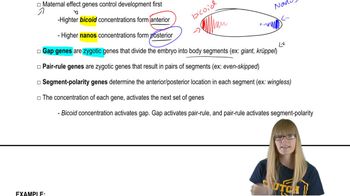Table of contents
- 1. Introduction to Genetics51m
- 2. Mendel's Laws of Inheritance3h 37m
- 3. Extensions to Mendelian Inheritance2h 41m
- 4. Genetic Mapping and Linkage2h 28m
- 5. Genetics of Bacteria and Viruses1h 21m
- 6. Chromosomal Variation1h 48m
- 7. DNA and Chromosome Structure56m
- 8. DNA Replication1h 10m
- 9. Mitosis and Meiosis1h 34m
- 10. Transcription1h 0m
- 11. Translation58m
- 12. Gene Regulation in Prokaryotes1h 19m
- 13. Gene Regulation in Eukaryotes44m
- 14. Genetic Control of Development44m
- 15. Genomes and Genomics1h 50m
- 16. Transposable Elements47m
- 17. Mutation, Repair, and Recombination1h 6m
- 18. Molecular Genetic Tools19m
- 19. Cancer Genetics29m
- 20. Quantitative Genetics1h 26m
- 21. Population Genetics50m
- 22. Evolutionary Genetics29m
13. Gene Regulation in Eukaryotes
Epigenetics, Chromatin Modifications, and Regulation
Problem 22b
Textbook Question
From the data in Table 19.3, draw up a list of histone H3 modifications associated with gene activation. Then draw up a list of H3 modifications associated with repression.
Are these overlaps explained by different modifications?
 Verified step by step guidance
Verified step by step guidance1
<span>Step 1: Understand the role of histone modifications in gene regulation. Histone modifications, such as methylation and acetylation, can influence gene expression by altering chromatin structure and accessibility.</span>
<span>Step 2: Identify histone H3 modifications associated with gene activation. Typically, modifications like H3K4me3 (trimethylation of lysine 4 on histone H3) and H3K9ac (acetylation of lysine 9 on histone H3) are linked to active transcription.</span>
<span>Step 3: Identify histone H3 modifications associated with gene repression. Common repressive modifications include H3K27me3 (trimethylation of lysine 27 on histone H3) and H3K9me3 (trimethylation of lysine 9 on histone H3).</span>
<span>Step 4: Compare the lists of modifications for activation and repression. Look for any overlaps or unique modifications that might explain differences in gene regulation.</span>
<span>Step 5: Analyze whether the overlaps in modifications are due to different contexts or additional factors, such as the presence of specific histone-modifying enzymes or the influence of other histone marks.</span>
Recommended similar problem, with video answer:
 Verified Solution
Verified SolutionThis video solution was recommended by our tutors as helpful for the problem above
Video duration:
1mPlay a video:
Was this helpful?
Key Concepts
Here are the essential concepts you must grasp in order to answer the question correctly.
Histone Modifications
Histone modifications refer to the chemical changes made to the histone proteins around which DNA is wrapped. These modifications, such as methylation and acetylation, can influence gene expression by altering the accessibility of the DNA to transcription machinery. Understanding these modifications is crucial for analyzing their roles in gene activation and repression.
Recommended video:
Guided course

Histone Protein Modifications
Gene Activation and Repression
Gene activation involves the processes that increase the expression of a gene, often facilitated by specific histone modifications that promote a more open chromatin structure. Conversely, gene repression refers to mechanisms that decrease gene expression, typically associated with histone modifications that lead to a more compact chromatin configuration. Recognizing these processes is essential for interpreting the data in the context of histone modifications.
Recommended video:
Guided course

Segmentation Genes
Functional Overlap of Modifications
Functional overlap of histone modifications occurs when certain modifications can have dual roles in both activating and repressing gene expression, depending on the context. This complexity suggests that the same modification may lead to different outcomes based on the presence of other modifications or the specific genomic environment. Understanding this overlap is key to answering whether the observed modifications can explain the differences in gene expression.
Recommended video:
Guided course

Functional Genomics





